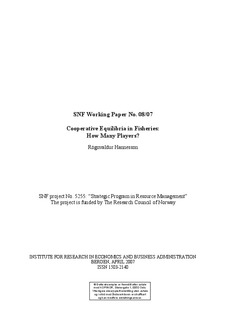| dc.contributor.author | Hannesson, Rögnvaldur | |
| dc.date.accessioned | 2007-09-21T10:46:47Z | |
| dc.date.available | 2007-09-21T10:46:47Z | |
| dc.date.issued | 2007-04 | |
| dc.identifier.issn | 1503-2140 | |
| dc.identifier.uri | http://hdl.handle.net/11250/166020 | |
| dc.description.abstract | This paper investigates conditions under which fisheries agreements between states are self-enforcing. Cooperative solutions can be self-enforcing if parties to the agreement punish those who depart from the cooperative solution by doing likewise, thereby causing a loss to the deviant that outweighs transient gains from deviation. Two kinds of deviation are examined: (i) effort deviation and (ii) time deviation. Both of these are linked to the excess capacity available in the fishery. It is investigated how the number of players that can be accommodated in a cooperative solution depends on fishing costs, the discount rate, and the growth rate of the fish stock, for a given level of excess fishing capacity. Furthermore, it is investigated how the possibility of maintaining a cooperative solution depends on the level of excess fishing capacity, and whether or not it would be profitable to invest in excess fishing capacity. Finally it is discussed how cost differences among players will affect the viability of the cooperative solution. | en |
| dc.language.iso | eng | en |
| dc.publisher | SNF | en |
| dc.relation.ispartofseries | Working paper | en |
| dc.relation.ispartofseries | 2007:8 | en |
| dc.title | Cooperative equilibria in fisheries : how many players? | en |
| dc.type | Working paper | en |
| dc.subject.nsi | VDP::Samfunnsvitenskap: 200::Økonomi: 210::Bedriftsøkonomi: 213 | en |
| dc.subject.nsi | VDP::Landbruks- og Fiskerifag: 900::Fiskerifag: 920::Fiskeriteknologi: 924 | en |
